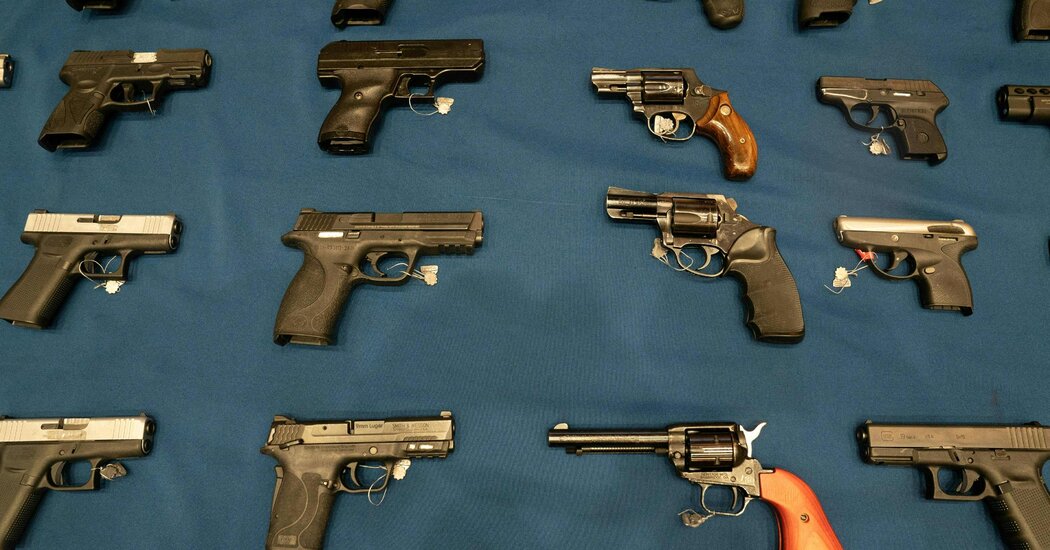Four in 10 illegal gun cases tracked by the Bureau of Alcohol, Tobacco, Firearms and Explosives were involved in black market sales, including from shadow dealers who used a legal loophole to evade background checks, according to an analysis of firearms trafficking released on Thursday.
About another 40 percent of gun investigations initiated by federal officials centered on illegal “straw” purchases made by proxies hired by criminals, or other people prohibited from legally buying weapons for themselves because of drug use or mental illnesses.
The report, part of a broader effort by the Biden administration to make public previously undisclosed firearms data, offered an expansive portrait of the country’s growing illegal firearms market — including the origin of weapons and trafficking patterns.
The study is the third of four scheduled to be released. It covers about 10,000 A.T.F. investigations from 2017 to 2021 — a period that included the biggest surge in gun violence in decades. But it is likely to undercount more recent developments, such as the rapid proliferation of deadly homemade weapons known as “ghost guns,” federal officials said.
The White House is likely to use the new data to muster support for regulations closing a loophole that has allowed kitchen-table dealers, gun-show vendors and online sellers to avoid background checks required of 80,000 federally licensed dealers by claiming they are not primarily “engaged in the business” of firearms sales.
The proposed rule change is part of President Biden’s piecemeal push to enact a key policy goal — universal background checks — which congressional Republicans have repeatedly stymied. Some gun rights advocates have vowed to fight the measure, saying the vast majority of sellers are law-abiding citizens or collectors.
“Individuals illegally engaged in the business of unlicensed firearms dealing are contributing more and more to the flow of firearms into the black market, where we know that felons, gang members and other violent offenders often get their guns,” said Steven M. Dettelbach, the A.T.F.’s director. “Americans need this data to understand this threat.”
The report also documented the expanding use of online platforms, social media and peer-to-peer platforms in illegal sales. The agency found that those collectively accounted for about 7 percent of illegal transactions.
Gun shows, flea markets and fairs made up a relatively small percentage of illegal sales, about 3 percent.
Federally licensed dealers directly sold a minuscule percentage of guns, less than 2 percent, later used in crimes. Nonetheless, many of the guns used to commit crimes originated with legal sales before being resold illegally, and around 18 percent of the illegal firearms tracked by the bureau had been stolen from federally licensed dealers.
The problem was particularly bad in Houston, New Orleans and Kansas City, which together accounted for a quarter of the cases brought in connection with guns stolen from dealers.
The report, taken in its entirety, confirmed long-held assumptions about trafficking patterns.
In most areas, weapons are transported within a single state, typically concealed in a car or truck. The exception is the Northeast, a region with tight gun laws and open transportation corridors that allow the easy inflow of guns from other parts of the country, especially the Southeast.
A majority of people investigated for owning, selling or using an illegal gun are white, more than 80 percent are men and the overwhelming majority — 95 percent — are U.S. citizens, according to the report.
Earlier tranches of the report, released over the past two years, have helped fill in some of the statistical gaps in gun trafficking data, which had not been publicly released for more than 20 years.
The first volume painted a vivid portrait of a nation arming itself to the teeth.
The annual number of firearms manufactured has nearly tripled since 2000 and spiked sharply in the past three years, according to a federal tally of gun commerce.
The data documented a drastic shift in consumer demand among gun owners that has had profound implications: Starting in 2009, Glock-type semiautomatic handguns, purchased for personal protection, began to outsell rifles, which have been typically used in hunting.
Another statistic in the 306-page document elicited concern among law enforcement officials. The police recovered 19,344 privately manufactured firearms, untraceable homemade weapons known as “ghost guns,” in 2021, a tenfold increase since 2016.


